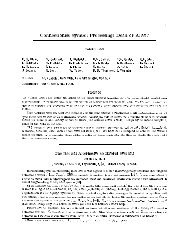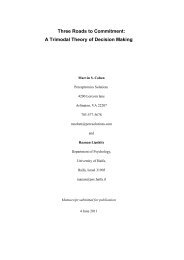Three Roads to Commitment: A Trimodal Theory of Decision Making
Three Roads to Commitment: A Trimodal Theory of Decision Making
Three Roads to Commitment: A Trimodal Theory of Decision Making
You also want an ePaper? Increase the reach of your titles
YUMPU automatically turns print PDFs into web optimized ePapers that Google loves.
<strong>Three</strong> <strong>Roads</strong> <strong>to</strong> <strong>Commitment</strong>: A <strong>Trimodal</strong> <strong>Theory</strong> <strong>of</strong> <strong>Decision</strong> <strong>Making</strong> 21<br />
characterization <strong>of</strong> a one-shot all-or-nothing tree felling strategy. The notion <strong>of</strong> intentions and commitment are also<br />
superfluous in idealized normative rational choice, because it ignores cognitive capacity limitations and regards<br />
proximity <strong>to</strong> time <strong>of</strong> implementation as in principle irrelevant (McClennen, 1990). Any choices, no matter how<br />
momen<strong>to</strong>us, can be recalculated at any time with an invariant result unless there is genuinely unanticipated new<br />
information .<br />
Recognition-Primed <strong>Decision</strong> <strong>Making</strong> (RPD)<br />
Figure 2 (upper right) represents RPD (Klein, 1993, 1998) by three TDM decision cycles. The first cycle (1a)<br />
matches the situation against a learned reper<strong>to</strong>ire <strong>of</strong> familiar patterns, which specify cues, expectancies, actions, and<br />
goals, and retrieves the most typical action (1b), which becomes the decision maker’s intention (2a). In relatively<br />
novel situations the decision maker reassesses it by mentally simulating its implementation (2a); if it survives this<br />
test (2b), the intention (2a) is implemented (3). In more familiar contexts, the first retrieved action may be executed<br />
immediately (1a,1b,3), without mental simulation.<br />
Hedge clipping<br />
Connolly & Wagner’s (1988) hedge clipping strategy involves a series <strong>of</strong> small commitments that target<br />
specific problems in the status quo rather than large decisions that target a globally desirable future state <strong>of</strong> affairs.<br />
In the former case, errors are easily corrected; in the latter case, they may be disastrous. Figure 2 (lower left)<br />
represents hedge clipping by means <strong>of</strong> four TDM decision cycles, with the possibility <strong>of</strong> continuing iterations. The<br />
first cycle (1a, 1b) involves either recognizing or simply guessing an appropriate action, which becomes the decision<br />
maker’s initial intention (2a). A criterion <strong>of</strong> appropriateness is that the action address a specific problem with the<br />
status quo, but allow for corrections if things go wrong. Instead <strong>of</strong> reassessing the action by mental simulation (as in<br />
RPD), the decision maker implements it (2a, 2b) and observes the outcome (2c). The success or failure <strong>of</strong> the action<br />
is then evaluated (3a). If it was a success (3b), the decision maker continues by further small steps in the same<br />
direction (cycle 4, which iterates cycle 2).<br />
Image theory<br />
In Figure 2 (lower right), which depicts processes specified in Image theory, six TDM cycles combine elements<br />
<strong>of</strong> all the previously discussed strategies. The first and second cycles are components <strong>of</strong> what Beach (1990) calls an<br />
adoption decision: Options must clear a compatibility test that resembles matching (1a), <strong>to</strong> screen out alternatives<br />
that conflict with the decision maker’s principles, goals, or on-going plans (1b). If more than one option survives<br />
(2a), the best is chosen by a pr<strong>of</strong>itability test (2b). (Choice, however, is decidedly less important than initial




